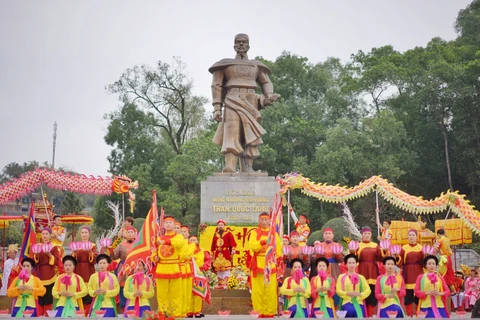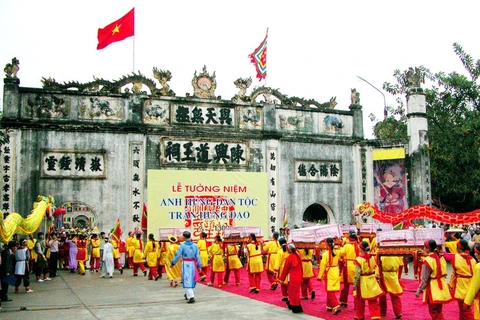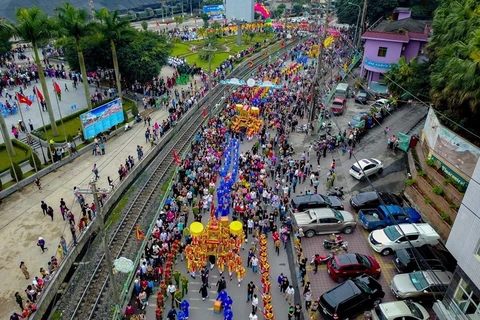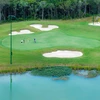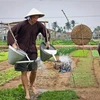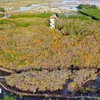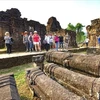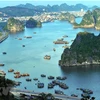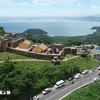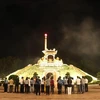 Cua Ong Temple is located on a hill that is about 100 metres high in Cua Ong ward of Cam Pha city, the northeastern province of Quang Ninh. It is around 40km to the northeast of downtown Ha Long, another city of Quang Ninh. The temple is dedicated to Tran Quoc Tang (1252 – 1313), a hero in the resistance wars against the Mongol invaders and guarding the country’s northeastern region under the Tran Dynasty (1225 – 1400). He was the third son of General Tran Quoc Tuan, who died in 1300. Tuan led Dai Viet (the name of Vietnam at that time) to two of the three victories against the Mongol invaders, in 1285 and 1288 (Photo: VietnamPlus)
Cua Ong Temple is located on a hill that is about 100 metres high in Cua Ong ward of Cam Pha city, the northeastern province of Quang Ninh. It is around 40km to the northeast of downtown Ha Long, another city of Quang Ninh. The temple is dedicated to Tran Quoc Tang (1252 – 1313), a hero in the resistance wars against the Mongol invaders and guarding the country’s northeastern region under the Tran Dynasty (1225 – 1400). He was the third son of General Tran Quoc Tuan, who died in 1300. Tuan led Dai Viet (the name of Vietnam at that time) to two of the three victories against the Mongol invaders, in 1285 and 1288 (Photo: VietnamPlus)  Apart from Tran Quoc Tang, Cua Ong Temple, previously called Cua Suot Temple, also worships his family members and inferior generals, and many other famous figures of the Tran Dynasty. It dates back more than 700 years. The temple complex features Thuong (Upper) Temple, Trung (Middle) Temple, Ha (Lower) Temple, Cap Tien Temple that is dedicated to a daughter of Tran Quoc Tang, along with a Buddhist pagoda. The gods’ stories, royal appointment documents, as well as statues dating back to the 19th century kept at Cua Ong Temple are valuable historical records that tell later generations about the national construction and safeguarding process of the Tran Dynasty (Photo: VietnamPlus)
Apart from Tran Quoc Tang, Cua Ong Temple, previously called Cua Suot Temple, also worships his family members and inferior generals, and many other famous figures of the Tran Dynasty. It dates back more than 700 years. The temple complex features Thuong (Upper) Temple, Trung (Middle) Temple, Ha (Lower) Temple, Cap Tien Temple that is dedicated to a daughter of Tran Quoc Tang, along with a Buddhist pagoda. The gods’ stories, royal appointment documents, as well as statues dating back to the 19th century kept at Cua Ong Temple are valuable historical records that tell later generations about the national construction and safeguarding process of the Tran Dynasty (Photo: VietnamPlus)  Cua Ong Temple is also closely linked with the traditions and spiritual life of local people. Thanks to its special values, this temple was recognised as a national historical relic site by the Ministry of Culture and Information, now the Ministry of Culture, Sports and Tourism, in Decision VH/QD, dated January 21, 1989. It was later listed as a special national historical relic site by the Prime Minister in Decision 2082/QD-TTg, issued on December 25, 2017. At present, Cua Ong Temple is one of the most famous destinations of spiritual tourism in Quang Ninh province and also among the most beautiful temples in Vietnam, attracting tens of thousands of visitors every year (Photo: VietnamPlus)
Cua Ong Temple is also closely linked with the traditions and spiritual life of local people. Thanks to its special values, this temple was recognised as a national historical relic site by the Ministry of Culture and Information, now the Ministry of Culture, Sports and Tourism, in Decision VH/QD, dated January 21, 1989. It was later listed as a special national historical relic site by the Prime Minister in Decision 2082/QD-TTg, issued on December 25, 2017. At present, Cua Ong Temple is one of the most famous destinations of spiritual tourism in Quang Ninh province and also among the most beautiful temples in Vietnam, attracting tens of thousands of visitors every year (Photo: VietnamPlus)  Columns that serve as the entrance to a temple in the Cua Ong Temple complex. The festival of Cua Ong Temple is held biennially, from the second to the fourth day of the second lunar month, with a number of rituals and festive activities. The event is meant to commemorate Tran Quoc Tang’s contributions to defeating the Mongol invaders and bringing peace to the northeastern region of the country. Festivities, including rituals and palanquin processions, usually last until the end of the third lunar month. The main festive days fall on the third and fourth days of the second lunar month (Photo: VietnamPlus)
Columns that serve as the entrance to a temple in the Cua Ong Temple complex. The festival of Cua Ong Temple is held biennially, from the second to the fourth day of the second lunar month, with a number of rituals and festive activities. The event is meant to commemorate Tran Quoc Tang’s contributions to defeating the Mongol invaders and bringing peace to the northeastern region of the country. Festivities, including rituals and palanquin processions, usually last until the end of the third lunar month. The main festive days fall on the third and fourth days of the second lunar month (Photo: VietnamPlus)  The Cua Ong Temple Festival, kicking off in the second lunar month, continues through the third lunar month with a wide range of activities, including incense offering rituals, cock fighting, Quan ho folk singing, boat racing, and folk games such as human chess, blindfolded clay pot breaking and tug of war. The boat racing by local residents represents their welcome for the gods and prayer for peace and bumper catch. In November 2016, together with 16 others nationwide, this festival was recognised as part of the national intangible cultural heritage by the Ministry of Culture, Sports and Tourism. Local authorities received the status certificate at an event on February 28, 2017 (Photo: VietnamPlus)
The Cua Ong Temple Festival, kicking off in the second lunar month, continues through the third lunar month with a wide range of activities, including incense offering rituals, cock fighting, Quan ho folk singing, boat racing, and folk games such as human chess, blindfolded clay pot breaking and tug of war. The boat racing by local residents represents their welcome for the gods and prayer for peace and bumper catch. In November 2016, together with 16 others nationwide, this festival was recognised as part of the national intangible cultural heritage by the Ministry of Culture, Sports and Tourism. Local authorities received the status certificate at an event on February 28, 2017 (Photo: VietnamPlus)  Besides the main festival in the second lunar month, another takes place on the third day of the eighth lunar month to commemorate the death of Tran Quoc Tang. The festival features an opening ceremony and a palanquin procession from Cua Ong Temple to a shrine in Trac Chan commune where the general was drifted in, and then back to the temple. A procession which is a special rite of the festival represents a patrol of the general and shows local people’s respect for him. Headed by a dragon dancing team, the procession is accompanied by several troupes in colourful costumes carrying colorful flags and beating drums. There is also an incense offering ceremony and the recreation of the legend about the general (Photo: VietnamPlus)
Besides the main festival in the second lunar month, another takes place on the third day of the eighth lunar month to commemorate the death of Tran Quoc Tang. The festival features an opening ceremony and a palanquin procession from Cua Ong Temple to a shrine in Trac Chan commune where the general was drifted in, and then back to the temple. A procession which is a special rite of the festival represents a patrol of the general and shows local people’s respect for him. Headed by a dragon dancing team, the procession is accompanied by several troupes in colourful costumes carrying colorful flags and beating drums. There is also an incense offering ceremony and the recreation of the legend about the general (Photo: VietnamPlus)  Another that makes Cua Ong Temple unique is that the site faces Bai Tu Long Bay, which is close to the world natural heritage site of Ha Long Bay. This gives it a special location – resting on the mountain and overlooking the sea. Along the way from the Lower Temple to the Upper Temple, visitors can admire the beauty of Bai Tu Long Bay, dotted with its numerous islands of all sizes. Bai Tu Long Bay is described as a secret heaven as it is less known than its sister Ha Long Bay. It covers the waters off the coast of Ha Long and Cam Pha cities, along with the island district of Van Don in Quang Ninh province (Photo: VietnamPlus)
Another that makes Cua Ong Temple unique is that the site faces Bai Tu Long Bay, which is close to the world natural heritage site of Ha Long Bay. This gives it a special location – resting on the mountain and overlooking the sea. Along the way from the Lower Temple to the Upper Temple, visitors can admire the beauty of Bai Tu Long Bay, dotted with its numerous islands of all sizes. Bai Tu Long Bay is described as a secret heaven as it is less known than its sister Ha Long Bay. It covers the waters off the coast of Ha Long and Cam Pha cities, along with the island district of Van Don in Quang Ninh province (Photo: VietnamPlus)  Some of the temples in the Cua Ong Temple complex. Cua Ong Temple was just a small shrine when it was first built over 700 years ago. It has been restored and expanded for many times in history. Apart from Tran Quoc Tang, the complex also worships his father Tran Quoc Tuan, also known as Tran Hung Dao, along with many other contributors to the triumphs over the Mongol invaders in the 13th century like Pham Ngu Lao, Da Tuong, Yet Kieu, Nguyen Khoai, Huyen Du, Cao Mang, Do Hanh, and Tran Quoc Toan. One of the temples in this complex is dedicated to the Mother Goddesses (Photo: VietnamPlus)
Some of the temples in the Cua Ong Temple complex. Cua Ong Temple was just a small shrine when it was first built over 700 years ago. It has been restored and expanded for many times in history. Apart from Tran Quoc Tang, the complex also worships his father Tran Quoc Tuan, also known as Tran Hung Dao, along with many other contributors to the triumphs over the Mongol invaders in the 13th century like Pham Ngu Lao, Da Tuong, Yet Kieu, Nguyen Khoai, Huyen Du, Cao Mang, Do Hanh, and Tran Quoc Toan. One of the temples in this complex is dedicated to the Mother Goddesses (Photo: VietnamPlus)  A temple in the Cua Ong Temple complex. Cua Ong Temple in Cam Pha city of Quang Ninh province is closely linked with the traditions and spiritual life of local people. Its festival, held in every even year, is the biggest of its kind in Cam Pha, attracting crowds of visitors from far and wide. It aims to commemorate Tran Quoc Tang’s contributions to defeating the Mongol enemy and bringing peace to the northeastern region of the country. The three victories over the invaders in 1258, 1285, and 1288 are regarded as among the greatest military feats in the world’s history (Photo: VietnamPlus)
A temple in the Cua Ong Temple complex. Cua Ong Temple in Cam Pha city of Quang Ninh province is closely linked with the traditions and spiritual life of local people. Its festival, held in every even year, is the biggest of its kind in Cam Pha, attracting crowds of visitors from far and wide. It aims to commemorate Tran Quoc Tang’s contributions to defeating the Mongol enemy and bringing peace to the northeastern region of the country. The three victories over the invaders in 1258, 1285, and 1288 are regarded as among the greatest military feats in the world’s history (Photo: VietnamPlus)  A stone stairway leading to some temples of the complex. Among the relics there, the Upper Temple is the main one worshipping Tran Quoc Tang. The complex is located on a hill that is about 100 metres high in Cua Ong ward of Cam Pha city, Quang Ninh province. It is around 40km to the northeast of downtown Ha Long, another city of Quang Ninh. Cua Ong Temple also faces Bai Tu Long Bay, which is close to the world natural heritage site of Ha Long Bay. All of these features give it a special location which rests on the mountain and overlooks the sea (Photo: VietnamPlus)
A stone stairway leading to some temples of the complex. Among the relics there, the Upper Temple is the main one worshipping Tran Quoc Tang. The complex is located on a hill that is about 100 metres high in Cua Ong ward of Cam Pha city, Quang Ninh province. It is around 40km to the northeast of downtown Ha Long, another city of Quang Ninh. Cua Ong Temple also faces Bai Tu Long Bay, which is close to the world natural heritage site of Ha Long Bay. All of these features give it a special location which rests on the mountain and overlooks the sea (Photo: VietnamPlus)  A view of Bai Tu Long Bay as seen from Cua Ong Temple. Thanks to its special location – resting on the mountain and overlooking the sea, the site has a rare and beautiful landscape. All of these factors have made Cua Ong Temple a magnet for visitors from across the country, thus greatly contributing to tourism development in Quang Ninh province. According to the provincial Tourism Department, due to COVID-19 impacts, Quang Ninh welcomed 5.8 million travellers between January and September 2020, only half of the figure recorded in the same time last year. It is striving to attract 3 million visitors in the fourth quarter (Photo: VietnamPlus)
A view of Bai Tu Long Bay as seen from Cua Ong Temple. Thanks to its special location – resting on the mountain and overlooking the sea, the site has a rare and beautiful landscape. All of these factors have made Cua Ong Temple a magnet for visitors from across the country, thus greatly contributing to tourism development in Quang Ninh province. According to the provincial Tourism Department, due to COVID-19 impacts, Quang Ninh welcomed 5.8 million travellers between January and September 2020, only half of the figure recorded in the same time last year. It is striving to attract 3 million visitors in the fourth quarter (Photo: VietnamPlus)  A temple in the Cua Ong Temple complex. This complex features Thuong (Upper) Temple, Trung (Middle) Temple, Ha (Lower) Temple, Cap Tien Temple that is dedicated to a daughter of Tran Quoc Tang, another dedicated to the Mother Goddesses, along with a Buddhist pagoda. Among them, the Upper Temple is the main one worshipping Tran Quoc Tang, a hero in the resistance wars against the Mongol invaders and guarding the country’s northeastern region under the Tran Dynasty. Tang is the third son of Tran Quoc Tuan, who was the commander-in-chief of the second and third resistance wars against the Mongol invaders and considered one of the most accomplished military tacticians in the world’s history (Photo: VietnamPlus)
A temple in the Cua Ong Temple complex. This complex features Thuong (Upper) Temple, Trung (Middle) Temple, Ha (Lower) Temple, Cap Tien Temple that is dedicated to a daughter of Tran Quoc Tang, another dedicated to the Mother Goddesses, along with a Buddhist pagoda. Among them, the Upper Temple is the main one worshipping Tran Quoc Tang, a hero in the resistance wars against the Mongol invaders and guarding the country’s northeastern region under the Tran Dynasty. Tang is the third son of Tran Quoc Tuan, who was the commander-in-chief of the second and third resistance wars against the Mongol invaders and considered one of the most accomplished military tacticians in the world’s history (Photo: VietnamPlus)  A temple in the Cua Ong Temple complex. Apart from Cua Ong Temple, the northeastern province of Quang Ninh is also home to a number of other destinations of spiritual tourism, including the Complex of Yen Tu Monuments and Landscape in Uong Bi city, Ba Vang Pagoda in Uong Bi, Cai Bau Pagoda in Van Don district, Ho Thien Pagoda in Dong Trieu town, along with Long Tien and Loi Am pagodas in Ha Long city. These sites attract a large number of visitors, especially in the spring when they come to pray for a new year of peace, good luck, good health, and prosperity (Photo: VietnamPlus)
A temple in the Cua Ong Temple complex. Apart from Cua Ong Temple, the northeastern province of Quang Ninh is also home to a number of other destinations of spiritual tourism, including the Complex of Yen Tu Monuments and Landscape in Uong Bi city, Ba Vang Pagoda in Uong Bi, Cai Bau Pagoda in Van Don district, Ho Thien Pagoda in Dong Trieu town, along with Long Tien and Loi Am pagodas in Ha Long city. These sites attract a large number of visitors, especially in the spring when they come to pray for a new year of peace, good luck, good health, and prosperity (Photo: VietnamPlus)  The worship of the Mother Goddesses is practiced at the Cua Ong Temple complex. This complex features many relics that are dedicated to not only Tran Quoc Tang or famed generals of the Tran Dynasty. They also include a temple dedicated to the Mother Goddesses. The practices related to the Vietnamese people’s beliefs in the Mother Goddesses of Three Realms (heaven, water, and mountains and forests), which have been passed down from generation to generation, were inscribed on the Representative List of the Intangible Cultural Heritage of Humanity by UNESCO in 2016. The worship of the Mother Goddesses also contributes to the appreciation of women and their roles in society (Photo: VietnamPlus)
The worship of the Mother Goddesses is practiced at the Cua Ong Temple complex. This complex features many relics that are dedicated to not only Tran Quoc Tang or famed generals of the Tran Dynasty. They also include a temple dedicated to the Mother Goddesses. The practices related to the Vietnamese people’s beliefs in the Mother Goddesses of Three Realms (heaven, water, and mountains and forests), which have been passed down from generation to generation, were inscribed on the Representative List of the Intangible Cultural Heritage of Humanity by UNESCO in 2016. The worship of the Mother Goddesses also contributes to the appreciation of women and their roles in society (Photo: VietnamPlus)  A woman offers prayers at Cua Ong Temple. Surrounded by several mountains, Cua Ong Temple was just a small shrine when it was first built over 700 years ago. It has been restored and expanded for many times in history and is now a large complex. While its exterior was constructed from various materials like stones, bricks from the renowned Bat Trang ceramic village in Hanoi, and baked clay, the interior was made from different types of wood like dinh (Erythrophloeum fordii Oliv), trac (Dalbergia cochinchinensis), and gu (Sindora tonkinensis). It is decorated with intricate carvings and red-lacquered and gold-inlaid boards engraved with characters of the old script (Photo: VietnamPlus)
A woman offers prayers at Cua Ong Temple. Surrounded by several mountains, Cua Ong Temple was just a small shrine when it was first built over 700 years ago. It has been restored and expanded for many times in history and is now a large complex. While its exterior was constructed from various materials like stones, bricks from the renowned Bat Trang ceramic village in Hanoi, and baked clay, the interior was made from different types of wood like dinh (Erythrophloeum fordii Oliv), trac (Dalbergia cochinchinensis), and gu (Sindora tonkinensis). It is decorated with intricate carvings and red-lacquered and gold-inlaid boards engraved with characters of the old script (Photo: VietnamPlus)  There are 34 intricately carved statues of all sizes with high artistic values in the temple at present. The temple is dedicated to Tran Quoc Tang, a hero in the resistance wars against the Mongol invaders and guarding the country’s northeastern region under the Tran Dynasty. He was the third son of Tran Quoc Tuan, also known as Tran Hung Dao, who led the country to two of the three victories against the Mongol invaders, in 1285 and 1288, along with many other contributors to the triumphs over the Mongol invaders in the 13th century. This temple is known as the only one in Vietnam worshipping all the family members and inferior generals of Tran Quoc Tuan (Photo: VietnamPlus)
There are 34 intricately carved statues of all sizes with high artistic values in the temple at present. The temple is dedicated to Tran Quoc Tang, a hero in the resistance wars against the Mongol invaders and guarding the country’s northeastern region under the Tran Dynasty. He was the third son of Tran Quoc Tuan, also known as Tran Hung Dao, who led the country to two of the three victories against the Mongol invaders, in 1285 and 1288, along with many other contributors to the triumphs over the Mongol invaders in the 13th century. This temple is known as the only one in Vietnam worshipping all the family members and inferior generals of Tran Quoc Tuan (Photo: VietnamPlus)  A woman offers prayers at Cua Ong Temple. The gods’ stories, royal appointment documents, as well as statues dating back to the 19th century kept at this temple complex are valuable historical records that tell later generations about the national construction and safeguarding process of the Tran Dynasty. Cua Ong Temple is also closely linked with the traditions and spiritual life of local people. Thanks to its special values, this temple was recognised as a national historical relic site by the Ministry of Culture and Information, now the Ministry of Culture, Sports and Tourism, in 1989. It was listed as a special national historical relic site by the Prime Minister in December 2017 (Photo: VietnamPlus)
A woman offers prayers at Cua Ong Temple. The gods’ stories, royal appointment documents, as well as statues dating back to the 19th century kept at this temple complex are valuable historical records that tell later generations about the national construction and safeguarding process of the Tran Dynasty. Cua Ong Temple is also closely linked with the traditions and spiritual life of local people. Thanks to its special values, this temple was recognised as a national historical relic site by the Ministry of Culture and Information, now the Ministry of Culture, Sports and Tourism, in 1989. It was listed as a special national historical relic site by the Prime Minister in December 2017 (Photo: VietnamPlus)  Women offer prayers at a temple of the complex. Cua Ong Temple is a popular destination of spiritual tourism in Quang Ninh. This province is believed to hold great potential and advantages for developing cultural and spiritual tourism as it is home to a large number of cultural and historical relic sites associated with nearly 80 traditional festivals, most of which take place in spring. Apart from preserving cultural and historical values of local relic sites, authorities of the province have also been working hard to upgrade the sites, offer new tours, train local tour guides, develop accompanied services, and improve transport infrastructure leading to relic sites (Photo: VietnamPlus)
Women offer prayers at a temple of the complex. Cua Ong Temple is a popular destination of spiritual tourism in Quang Ninh. This province is believed to hold great potential and advantages for developing cultural and spiritual tourism as it is home to a large number of cultural and historical relic sites associated with nearly 80 traditional festivals, most of which take place in spring. Apart from preserving cultural and historical values of local relic sites, authorities of the province have also been working hard to upgrade the sites, offer new tours, train local tour guides, develop accompanied services, and improve transport infrastructure leading to relic sites (Photo: VietnamPlus)  A worshipping hall of Cua Ong Temple. The festival of Cua Ong Temple is held biennially, from the second to the fourth day of the second lunar month, with a number of rituals and festive activities. The event is meant to pay tribute to Tran Quoc Tang, who greatly contributed to defeating the Mongol invaders and bringing peace to the northeastern region of the country in the 13th century. Festivities, including rituals and palanquin processions, usually last until the end of the third lunar month. The main festive days fall on the third and fourth days of the second lunar month (Photo: VietnamPlus)
A worshipping hall of Cua Ong Temple. The festival of Cua Ong Temple is held biennially, from the second to the fourth day of the second lunar month, with a number of rituals and festive activities. The event is meant to pay tribute to Tran Quoc Tang, who greatly contributed to defeating the Mongol invaders and bringing peace to the northeastern region of the country in the 13th century. Festivities, including rituals and palanquin processions, usually last until the end of the third lunar month. The main festive days fall on the third and fourth days of the second lunar month (Photo: VietnamPlus)  Altars, intricate carvings, along with red-lacquered and gold-inlaid boards engraved with the old script’s characters at a temple in the complex. These traditional-style decorations also contribute to the uniqueness of Cua Ong Temple, one of the most beautiful temples in Vietnam. The Cua Ong Temple Festival, kicking off in the second lunar month, continues through the third lunar month with a wide range of activities, including incense offering rituals, cock fighting, Quan ho folk singing, boat racing, and folk games such as human chess, blindfolded clay pot breaking, tug of war. In November 2016, it was recognised as part of the national intangible cultural heritage by the Ministry of Culture, Sports and Tourism (Photo: VietnamPlus)
Altars, intricate carvings, along with red-lacquered and gold-inlaid boards engraved with the old script’s characters at a temple in the complex. These traditional-style decorations also contribute to the uniqueness of Cua Ong Temple, one of the most beautiful temples in Vietnam. The Cua Ong Temple Festival, kicking off in the second lunar month, continues through the third lunar month with a wide range of activities, including incense offering rituals, cock fighting, Quan ho folk singing, boat racing, and folk games such as human chess, blindfolded clay pot breaking, tug of war. In November 2016, it was recognised as part of the national intangible cultural heritage by the Ministry of Culture, Sports and Tourism (Photo: VietnamPlus)  Cua Ong Temple is not only a destination of spiritual tourism but also boasts numerous historical and cultural values that are useful for educating the young about the country’s history and culture. In recent years, authorities of Cam Pha city have worked to promote values of this special national historical relic site. Vice Chairman of the Cam Pha People’s Committee Dinh Ngoc Chien said the city has been upgrading and expanding local historical, cultural, and architectural relic sites so as to preserve their values and attract visitors. Authorities are striving towards sustainable development of cultural and spiritual tourism so that it can contribute more to the common growth of the whole tourism sector as well as socio-economic development of Quang Ninh (Photo: VietnamPlus)
Cua Ong Temple is not only a destination of spiritual tourism but also boasts numerous historical and cultural values that are useful for educating the young about the country’s history and culture. In recent years, authorities of Cam Pha city have worked to promote values of this special national historical relic site. Vice Chairman of the Cam Pha People’s Committee Dinh Ngoc Chien said the city has been upgrading and expanding local historical, cultural, and architectural relic sites so as to preserve their values and attract visitors. Authorities are striving towards sustainable development of cultural and spiritual tourism so that it can contribute more to the common growth of the whole tourism sector as well as socio-economic development of Quang Ninh (Photo: VietnamPlus)  Dating back over 700 years, the Cua Ong Temple complex features the Upper Temple, Middle Temple, Lower Temple, Cap Tien Temple, another dedicated to the Mother Goddesses, along with a Buddhist pagoda. Among them, the Upper Temple is the main one worshipping Tran Quoc Tang (1252 – 1313), a hero in the resistance wars against the Mongol invaders and guarding the country’s northeastern region under the Tran Dynasty. Besides the main festival in the second lunar month, another takes place on the third day of the eighth lunar month to commemorate the death of Tran Quoc Tang. Tang was the third son of Tran Quoc Tuan, who led the country to two of the three victories against the Mongol invaders (Photo: VietnamPlus)
Dating back over 700 years, the Cua Ong Temple complex features the Upper Temple, Middle Temple, Lower Temple, Cap Tien Temple, another dedicated to the Mother Goddesses, along with a Buddhist pagoda. Among them, the Upper Temple is the main one worshipping Tran Quoc Tang (1252 – 1313), a hero in the resistance wars against the Mongol invaders and guarding the country’s northeastern region under the Tran Dynasty. Besides the main festival in the second lunar month, another takes place on the third day of the eighth lunar month to commemorate the death of Tran Quoc Tang. Tang was the third son of Tran Quoc Tuan, who led the country to two of the three victories against the Mongol invaders (Photo: VietnamPlus)  The three-door gate of a temple in the complex. The festival held at Cua Ong Temple on the third day of the eighth lunar month features an opening ceremony and a palanquin procession from Cua Ong Temple to a shrine in Trac Chan commune where the general was drifted in, and then back to the temple. A procession which is a special rite of the festival represents a patrol of the general and shows local people’s respect for him. Headed by a dragon dancing team, the procession is accompanied by several troupes in colourful costumes carrying colorful flags and beating drums. There is also an incense offering ceremony and the recreation of the legend about the general (Photo: VietnamPlus)
The three-door gate of a temple in the complex. The festival held at Cua Ong Temple on the third day of the eighth lunar month features an opening ceremony and a palanquin procession from Cua Ong Temple to a shrine in Trac Chan commune where the general was drifted in, and then back to the temple. A procession which is a special rite of the festival represents a patrol of the general and shows local people’s respect for him. Headed by a dragon dancing team, the procession is accompanied by several troupes in colourful costumes carrying colorful flags and beating drums. There is also an incense offering ceremony and the recreation of the legend about the general (Photo: VietnamPlus)  A traditional-style resting place at Cua Ong Temple. Apart from this temple complex, the northeastern province of Quang Ninh is also home to a number of other destinations of spiritual tourism, including the Complex of Yen Tu Monuments and Landscape in Uong Bi city, Ba Vang Pagoda in Uong Bi, Cai Bau Pagoda in Van Don district, Ho Thien Pagoda in Dong Trieu town, along with Long Tien and Loi Am pagodas in Ha Long city. These sites are magnets for tourists from across the country, especially in the spring when they come to pray for peace, good luck, good health, and prosperity in a new year (Photo: VietnamPlus)
A traditional-style resting place at Cua Ong Temple. Apart from this temple complex, the northeastern province of Quang Ninh is also home to a number of other destinations of spiritual tourism, including the Complex of Yen Tu Monuments and Landscape in Uong Bi city, Ba Vang Pagoda in Uong Bi, Cai Bau Pagoda in Van Don district, Ho Thien Pagoda in Dong Trieu town, along with Long Tien and Loi Am pagodas in Ha Long city. These sites are magnets for tourists from across the country, especially in the spring when they come to pray for peace, good luck, good health, and prosperity in a new year (Photo: VietnamPlus)  People offer prayers at a worshipping hall of Cua Ong Temple. The temple has been restored and expanded for many times in history and is now a large complex. Apart from Tran Quoc Tang, it also worships his father Tran Quoc Tuan and many other contributors to the triumphs over the Mongol invaders in the 13th century. Its interior was made from different types of wood like dinh (Erythrophloeum fordii Oliv), trac (Dalbergia cochinchinensis), and gu (Sindora tonkinensis). It is decorated with fine carvings and red-lacquered and gold-inlaid boards engraved with the old script’s characters. There are 34 intricately carved statues of all sizes with high artistic values in the temple at present (Photo: VietnamPlus)
People offer prayers at a worshipping hall of Cua Ong Temple. The temple has been restored and expanded for many times in history and is now a large complex. Apart from Tran Quoc Tang, it also worships his father Tran Quoc Tuan and many other contributors to the triumphs over the Mongol invaders in the 13th century. Its interior was made from different types of wood like dinh (Erythrophloeum fordii Oliv), trac (Dalbergia cochinchinensis), and gu (Sindora tonkinensis). It is decorated with fine carvings and red-lacquered and gold-inlaid boards engraved with the old script’s characters. There are 34 intricately carved statues of all sizes with high artistic values in the temple at present (Photo: VietnamPlus)  The location of Cua Ong Temple, on a hill that is about 100 metres high in Cua Ong ward of Cam Pha city, gives this relic site a beautiful view. In recent years, local authorities have also made efforts to make it more attractive to visitors by upgrading and expanding the site while still preserving its traditional cultural and historical values. While Cua Ong Temple was listed as a special national historical relic site in December 2017, the festival that kicks off in the second lunar month of every even year there was recognised as part of the national intangible cultural heritage in November 2016 (Photo: VietnamPlus)
The location of Cua Ong Temple, on a hill that is about 100 metres high in Cua Ong ward of Cam Pha city, gives this relic site a beautiful view. In recent years, local authorities have also made efforts to make it more attractive to visitors by upgrading and expanding the site while still preserving its traditional cultural and historical values. While Cua Ong Temple was listed as a special national historical relic site in December 2017, the festival that kicks off in the second lunar month of every even year there was recognised as part of the national intangible cultural heritage in November 2016 (Photo: VietnamPlus)  The roof of a structure at Cua Ong Temple. The festival of Cua Ong Temple is held biennially, from the second to the fourth day of the second lunar month every even year, with a number of rituals and festive activities. The event is held to pay tribute to Tran Quoc Tang, who contributed to defeating the Mongol invaders and bringing peace to the northeastern region of the country. Festivities, including rituals, parades, and palanquin processions, usually last until the end of the third lunar month. The main festive days fall on the third and fourth days of the second lunar month (Photo: VietnamPlus)
The roof of a structure at Cua Ong Temple. The festival of Cua Ong Temple is held biennially, from the second to the fourth day of the second lunar month every even year, with a number of rituals and festive activities. The event is held to pay tribute to Tran Quoc Tang, who contributed to defeating the Mongol invaders and bringing peace to the northeastern region of the country. Festivities, including rituals, parades, and palanquin processions, usually last until the end of the third lunar month. The main festive days fall on the third and fourth days of the second lunar month (Photo: VietnamPlus)  The tomb of Tran Quoc Tang behind the Thuong (Upper) Temple. Tran Quoc Tang (1252 – 1313) was a hero in the resistance wars against the Mongol invaders and guarding the country’s northeastern region under the Tran Dynasty (1225 – 1400). His father, Tran Quoc Tuan (also known as Tran Hung Dao), was the commander-in-chief of the second and third resistance wars against the Mongol invaders and considered one of the most accomplished military tacticians in the world’s history, leading the country to victories. The three triumphs over the enemy in 1258, 1285, and 1288 are regarded as one of the greatest military feats in the world (Photo: VietnamPlus)
The tomb of Tran Quoc Tang behind the Thuong (Upper) Temple. Tran Quoc Tang (1252 – 1313) was a hero in the resistance wars against the Mongol invaders and guarding the country’s northeastern region under the Tran Dynasty (1225 – 1400). His father, Tran Quoc Tuan (also known as Tran Hung Dao), was the commander-in-chief of the second and third resistance wars against the Mongol invaders and considered one of the most accomplished military tacticians in the world’s history, leading the country to victories. The three triumphs over the enemy in 1258, 1285, and 1288 are regarded as one of the greatest military feats in the world (Photo: VietnamPlus)  The statue of Tran Quoc Tang at Cua Ong Temple. This temple complex is a famous destination of spiritual tourism in Quang Ninh. This province is believed to hold great potential and advantages for developing cultural and spiritual tourism as it is home to a large number of cultural and historical relic sites associated with nearly 80 traditional festivals, most of which take place in spring. Apart from preserving cultural and historical values of local relic sites, authorities of the province have also been working hard to upgrade the sites, offer new tours, train local tour guides, develop accompanied services, and improve transport infrastructure leading to the relic sites (Photo: VietnamPlus)
The statue of Tran Quoc Tang at Cua Ong Temple. This temple complex is a famous destination of spiritual tourism in Quang Ninh. This province is believed to hold great potential and advantages for developing cultural and spiritual tourism as it is home to a large number of cultural and historical relic sites associated with nearly 80 traditional festivals, most of which take place in spring. Apart from preserving cultural and historical values of local relic sites, authorities of the province have also been working hard to upgrade the sites, offer new tours, train local tour guides, develop accompanied services, and improve transport infrastructure leading to the relic sites (Photo: VietnamPlus) VNA
